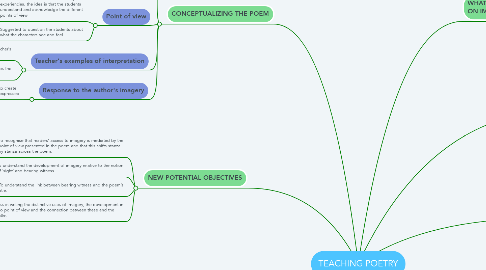
1. CONCLUSIONS
1.1. The objectives developed during the revised class cannot be applied to other poems
1.2. The ways of analysing the poem can be applied to any other
1.3. The details you emphasise from one poem to the next will vary but the underlying approach of identifying aspects that can provide a key to understanding and deeper response holds true across many.
1.4. A teaching poetry lesson must do justice to the poem itself by deeply analysing its content
2. CONCEPTUALIZING THE POEM
2.1. Creating context
2.1.1. Questions in relations to the poems topic (expected to know if there's any previous knowledge)
2.1.2. Developing a mental picture of the poem itself
2.1.3. Understanding the author's intentions while writting the story
2.2. Point of view
2.2.1. The characters in the poems are living experiencies, the idea is that the students understand and acknowledge the different points of view
2.2.2. Suggested to question the students about what the characters see and feel.
2.3. Teacher's examples of interpretation
2.3.1. Guide to students based on teacher's previous analysis
2.3.2. Written example of the activities the students will develop
2.4. Response to the author's imagery
2.4.1. Along the process, students are to create an answer to what the writer has expressed
2.4.1.1. It could be done taking in consideration the example previously provided
3. NEW POTENTIAL OBJECTIVES
3.1. To recognise that readers’ access to imagery is mediated by the point of view presented in the poem and that this shifts stanza by stanza across the poem.
3.2. To understand the development of imagery relative to the notion of ‘sight’ and bearing witness.
3.3. To understand the link between bearing witness and the poem’s title.
3.4. To express in writing the distinctive uses of imagery, the development in relation to point of view and the connection between these and the poem’s title.
4. WHAT IS TEACHING FOCUSED ON IMAGERY?
4.1. According to Cambridge: The use of words or pictures in books, films, paintings, etc. to describe ideas or situations.
4.2. According to Broudy, Harry S (1986) Imagery plays a central role in children's ability to develop concepts, values, and skills, particularly language skills.
4.2.1. Although this is not discussed in detail, the theory implies that discpline-based arts education as part of general education must be teachable by the classroom teacher with the same degree of competence demanded by the teaching of other required subjects
5. LESSON BREAK-UP
5.1. She starts the lesson by sharing objectives with pupils, and shows them a PowerPoint slide
5.1.1. She reads these aloud and gives some further verbal explanation of the term imagery, asking pupils to think about the concept like a ‘film in the head’: how words help you see scenes, people and details in your mind, changing as the poem develops.
5.1.1.1. Martine plays pupils the audio version of the poem twice and they have the printed version on their desks in front of them on each occasion.
